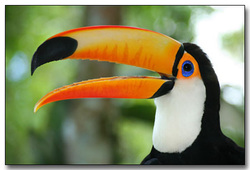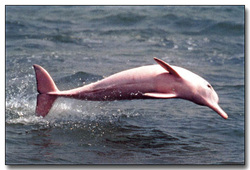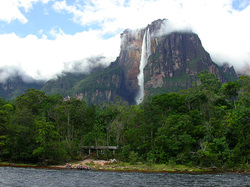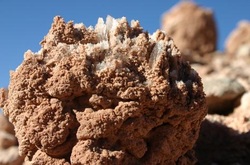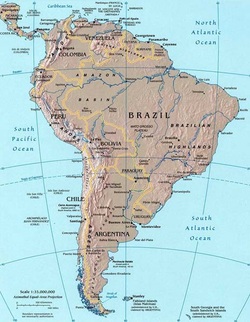
Our next stop...Middle and South America....
Middle America, or sometimes called "Central America"and South America together have 29 Countries. Middle America which is the bridge between North and South America has 8 countries: Mexico, Belize, Guatemala, El Salvador, Honduras, Nicaragua, Costa Rica and Panama
South America has 15 independent countries: Venezuela, Guyana, French Guiana, Colombia, Ecuador, Peru, Brazil, Bolivia, Paraguay,Chile, Argentina and Uruguay and 3 major territories: Falkland Islands, Galapagos Islands and French Guiana. Then we have the Caribbean Nations: Cuba, Jamaica, Haiti, Dominican Republic, Bahamas and Puerto Rico together all these countries make up Middle and South America and we are going to go visit our 5 amazing features and some fun facts of each.
Middle America, or sometimes called "Central America"and South America together have 29 Countries. Middle America which is the bridge between North and South America has 8 countries: Mexico, Belize, Guatemala, El Salvador, Honduras, Nicaragua, Costa Rica and Panama
South America has 15 independent countries: Venezuela, Guyana, French Guiana, Colombia, Ecuador, Peru, Brazil, Bolivia, Paraguay,Chile, Argentina and Uruguay and 3 major territories: Falkland Islands, Galapagos Islands and French Guiana. Then we have the Caribbean Nations: Cuba, Jamaica, Haiti, Dominican Republic, Bahamas and Puerto Rico together all these countries make up Middle and South America and we are going to go visit our 5 amazing features and some fun facts of each.
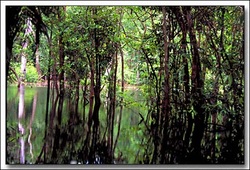
Our First Feature is the Amazon Rain Forest.
The Amazon Rain Forest is is the largest rainforest in the world. There is only 54% of rain forests left in the world today. The Amazon Rain Forest is 2.5 million square miles encumbering 2/3 of South America. It runs through Brazil, Colombia, Peru, Venezuela, Ecuador, Bolivia and the Guianas and 20% of the oxygen on earth is produced here also. 90% of the plants that make up the habitat have not had a chance to be studied some of the reasons for this is the location. There are an estimate of 250,000 Amazon Natives that live here in the Amazon Forest and they eat about ½ of the fruits that are produced. Out of all the natives that live here only about 50 of these tribes have seen anything anywhere else in the world.
The Amazon Rain Forest is is the largest rainforest in the world. There is only 54% of rain forests left in the world today. The Amazon Rain Forest is 2.5 million square miles encumbering 2/3 of South America. It runs through Brazil, Colombia, Peru, Venezuela, Ecuador, Bolivia and the Guianas and 20% of the oxygen on earth is produced here also. 90% of the plants that make up the habitat have not had a chance to be studied some of the reasons for this is the location. There are an estimate of 250,000 Amazon Natives that live here in the Amazon Forest and they eat about ½ of the fruits that are produced. Out of all the natives that live here only about 50 of these tribes have seen anything anywhere else in the world.
1/3 of the birds on earth live here in the Amazon Forest and most of them are Toucans.
Our next stop we will look at the Amazon River
The Amazon River flows more than 4,000 miles long and was discovered by a Spanish explorer named Francisco de Orellanathe. Francisco named the river after wild women warriors.
The Amazon River flows more than 4,000 miles long and was discovered by a Spanish explorer named Francisco de Orellanathe. Francisco named the river after wild women warriors.
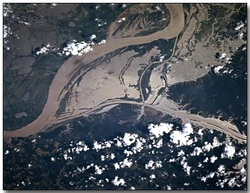
The Amazon River flows through Brazil, Bolivia, Peru, Ecuador, Colombia, Venezuela, Guyana, French Guinesa and Suriname. But at least 60% of it is in Brazil.
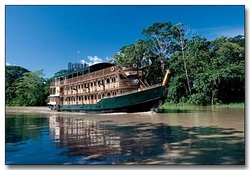
For entertainment on the river you can rent riverboats and fish for Piranhas. There is wildlife tracking, jungle treks and you can even do some nighttime cayman-spotting. Make sure you go in June and July for the best river access.
The most amazing thing I have found out about the Amazon River is that it is the only place to see a pink dolphin.
Just when you are enjoying the river I believe the most intriguing part of this region is the Angel Falls.
Angel Falls is the highest waterfall in the world. It has an uninterrupted fall of 2,648 feet and is located in Guayana highlands. Angel Falls is 15 times higher than Niagara Falls.
Angel Falls is the highest waterfall in the world. It has an uninterrupted fall of 2,648 feet and is located in Guayana highlands. Angel Falls is 15 times higher than Niagara Falls.
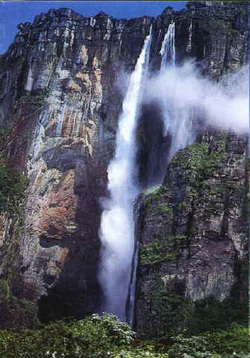
Angel Falls was named after James Crawford Angel, a Missouri pilot, who landed his plane there looking for the Golden City. The Native Pemon people live here with interesting plants and animals.
Angel Falls has white sandy beaches, beautiful scenery and of course the waterfall. If you get a chance to see this amazing waterfall make sure you take a swim there.
Moving along on our journey we will explore the
Andes Mountains.
Moving along on our journey we will explore the
Andes Mountains.
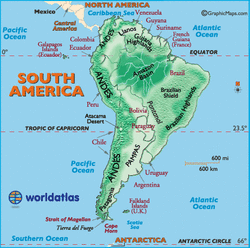
The Andes Mountains are 4,500 miles long running from the southern tip of South America to Panama. The countries it runs through are Venezuela, Colombia, Ecuador, Peru, Bolivia, Chile and Argentina. The highest peak is Aconcagua in Argentina at 22,384 feet.
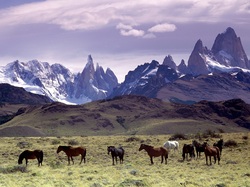
Located in the Andes are two of the world's largest volcanoes the Chimborazo and Cotopaxi. They were formed during the Cretaceous Period from the moving of the tectonic plates that created the mountains folds. It is estimated that there are about 30 million people that live in the Andes.
Our final stop to explore is the Atacama Desert.
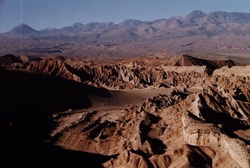
The Atacama Desert is known as the "driest place on earth."It is called this because it does not rain that often there. Records show that on an average it only rains .004 inches/.01cm per year. In some places of the desert there has been no rain for over
400 years. In some areas of the desert no vegetation will grow.
400 years. In some areas of the desert no vegetation will grow.
The Atacama Desert is around 6 miles long and runs along the coast of Chile. It has frequent severe earthquakes and is a source for nitrate and copper wealth. Up in the higher elevations you can find snow. When wondering around the salty lakes you can find flamingos that live around there.
Now let's move on and find out some of the facts about this region.
First off we will start by looking at the different types of climates you can find in is region. Because of the different altitudes in this region here is the climates found:
Terra Caliente – this is at sea level to 2,500 feet in altitude. Tropical rainforests are here and this is where sugarcane and bananas grow. You can also find manioc, sweet potatoes, yams, maize, beans and rice. Some cattle are farmed here also and is the most populated area.
Tierra Templada - is 2,500 feet to 6,000 feet in altitude. Is cooler in temperatures here and is the most populated area. Coffee is the main crop harvested here with maize, wheat, beans and vegetables.
Tierra Fria- is 6,000 feet to 12,000 feet in altitude. Is known as the “cold land” and is the tree line. This is also the highest zone in Central America. Wheat, barley, potatoes and maize grow here. You will find the Inca here.
Puna – is 12,000 feet to 15,000 feet in altitude. It is a very cold region and you can find some grass for sheep, llama, vicuna and el paca.
Tierra Helada – is 15,000 feet and higher. Here it is snow and ice.
When we take a look at the roles of the genders we find that with men masculinity is started at a young age. This is influenced by the family and community. They are taught then what is expected of them. Their main role is to be the providers and in control using force if necessary. If there is no work then they must leave their area and go where they can find work in which case they send money home for their family. Most of their work is part time jobs that don't last long. These jobs consist of construction, maintenance, street vendors, car washers or are involved in crime. They have more freedom than do the women.
The role of the women is to follow the role model of the Virgin Mary. They follow chastity to motherhood then to service her family. Women are in charge of keeping up with the everyday activities of the house and to be a teacher to her son and to show her daughters how to be servers in their homes. Women do not have much space outside of the home and their best friends end up being family members. They marry young and have few children now so they are able to get a job once they have raised their children.
First off we will start by looking at the different types of climates you can find in is region. Because of the different altitudes in this region here is the climates found:
Terra Caliente – this is at sea level to 2,500 feet in altitude. Tropical rainforests are here and this is where sugarcane and bananas grow. You can also find manioc, sweet potatoes, yams, maize, beans and rice. Some cattle are farmed here also and is the most populated area.
Tierra Templada - is 2,500 feet to 6,000 feet in altitude. Is cooler in temperatures here and is the most populated area. Coffee is the main crop harvested here with maize, wheat, beans and vegetables.
Tierra Fria- is 6,000 feet to 12,000 feet in altitude. Is known as the “cold land” and is the tree line. This is also the highest zone in Central America. Wheat, barley, potatoes and maize grow here. You will find the Inca here.
Puna – is 12,000 feet to 15,000 feet in altitude. It is a very cold region and you can find some grass for sheep, llama, vicuna and el paca.
Tierra Helada – is 15,000 feet and higher. Here it is snow and ice.
When we take a look at the roles of the genders we find that with men masculinity is started at a young age. This is influenced by the family and community. They are taught then what is expected of them. Their main role is to be the providers and in control using force if necessary. If there is no work then they must leave their area and go where they can find work in which case they send money home for their family. Most of their work is part time jobs that don't last long. These jobs consist of construction, maintenance, street vendors, car washers or are involved in crime. They have more freedom than do the women.
The role of the women is to follow the role model of the Virgin Mary. They follow chastity to motherhood then to service her family. Women are in charge of keeping up with the everyday activities of the house and to be a teacher to her son and to show her daughters how to be servers in their homes. Women do not have much space outside of the home and their best friends end up being family members. They marry young and have few children now so they are able to get a job once they have raised their children.
Another topic we will look at is the role of religion in Middle and South America.
The majority of the population here is Roman Catholic. The Indigenous people created their own way to practice Catholicism. By doing this they added music and other performances to perform scripts different from the original of the Europeans. They used to use their wealth for themselves ignoring the poor, but now things have changed and they do tend to them and the women are allowed to perform some tasks. Evangelical Protestantism is growing and is more the poor that are practicing this to try to better the future. Some of the other religions here are Judaism, Islam, Hinduism, and indigenous beliefs. Some African religions found are Condomble, Umbanda, Santeria, Obeah and Voodoo.
Population
Population in Middle and South America is approximately 230 million more people than in North America. The higher population is starting to increase more and more. This increasing population is happening from the region itself and not from people settling from other countries. The increase in birth rates is the how the population is growing. The population is unevenly distributed with most the population in the higher lands living in Mexico City, Columbia and Ecuador. The lower land population lives along the coasts with the water helping with the humidity and heat.
Environmental Issues
Back in the 1970's when the Trans-American Highway was constructed it destroyed part of the rain forest. When the farmers moved in the growing of crops and grazing of cattle also caused the forest to be cut down. Loggers also destroyed the trees and underlying minerals.
Transportation
Some of the different transportation you will find in this region is cars and buses that use the highway that was built. In the cities there are taxis and in few congested cities there are cars and bicycles. The ferries are used for water travel and in and out of the region is traveled by airplane.
Population in Middle and South America is approximately 230 million more people than in North America. The higher population is starting to increase more and more. This increasing population is happening from the region itself and not from people settling from other countries. The increase in birth rates is the how the population is growing. The population is unevenly distributed with most the population in the higher lands living in Mexico City, Columbia and Ecuador. The lower land population lives along the coasts with the water helping with the humidity and heat.
Environmental Issues
Back in the 1970's when the Trans-American Highway was constructed it destroyed part of the rain forest. When the farmers moved in the growing of crops and grazing of cattle also caused the forest to be cut down. Loggers also destroyed the trees and underlying minerals.
Transportation
Some of the different transportation you will find in this region is cars and buses that use the highway that was built. In the cities there are taxis and in few congested cities there are cars and bicycles. The ferries are used for water travel and in and out of the region is traveled by airplane.
Now for my favorite part of the fun facts "Cuisine." We will now look at the different foods eaten in Middle and South America.
Because of the many cultures in Middle and South America here is a few of the cuisines that are enjoyed. Argentina and Chile is mainly Italian restaurants and pizzerias, ice cream parlors, coffee, tea, fresh juices, suckling pig and various cuts of meat and sea food. Chilean wines and beers are of favorites. Colombia with coffee of course, guinea pig, mint or camomile tea, tamales and fried ants. Venezuela is shredded beefs, barbequed meats, fish stewed with vegetables, fruit juices and milk shakes. Ecuador is tropical fruits and seafood’s, beef, vegetables, corn pancakes, soups with potatoes, blood sausage. Brazil, rice and bean dishes.
Yum! huh? Well thanks for joining me and I look forward to our next stop...Europe.
References:
Encyclopedia.com (2011). Atacama Desert. Retrieved from http://www.encyclopedia.com
Galapagos & Ecuador Guide (2003-2011). Volcano Watching in Ecuador and the Galapagos Islands is an experience that will last for a lifetime. Retrieved from http://www.galapagos-islands-tourguide.com
Harper College (no copyright). Middle America: Altitude Zonation. Retrieved from
http://www.harpercollege.edu/mhealy/g101ilec/midamerica
Kewl Wallpapers.com (2009). Andes Mountains Patagonia Argentina wallpaper. Retrieved from http://www.kewlwallpapers.com
Pulsipher, L. M., and Pulsipher, A. (2008). World Regional Geography: Global Patterns, Local
Lives (4th ed.). New York: W. H. Freeman and Company.
Salto Angel – Angel Falls Venezuela (2011). Angel Falls: Myths Facts Travel. Retrieved from h:ttp://www.salto-angel.com
Unique-South America Travel-Experience.com (2006-2011). The Absolute Insider Guide to South America Travel. Retrieved from
http://www.unique-southamericatravel-experience.com
Wallpaper Challenge (2011). Just another WordPress site: Angel Falls. Retrieved from http://wallpaperchallenge.com
World Atlas Explore your World...(no copyrigts). Middle America. Retrieved from http:// www.worldatlas.com
World Atlas Explore your World...(no copyrights). South America. Retrieved from http://www.worldatlas.com
Encyclopedia.com (2011). Atacama Desert. Retrieved from http://www.encyclopedia.com
Galapagos & Ecuador Guide (2003-2011). Volcano Watching in Ecuador and the Galapagos Islands is an experience that will last for a lifetime. Retrieved from http://www.galapagos-islands-tourguide.com
Harper College (no copyright). Middle America: Altitude Zonation. Retrieved from
http://www.harpercollege.edu/mhealy/g101ilec/midamerica
Kewl Wallpapers.com (2009). Andes Mountains Patagonia Argentina wallpaper. Retrieved from http://www.kewlwallpapers.com
Pulsipher, L. M., and Pulsipher, A. (2008). World Regional Geography: Global Patterns, Local
Lives (4th ed.). New York: W. H. Freeman and Company.
Salto Angel – Angel Falls Venezuela (2011). Angel Falls: Myths Facts Travel. Retrieved from h:ttp://www.salto-angel.com
Unique-South America Travel-Experience.com (2006-2011). The Absolute Insider Guide to South America Travel. Retrieved from
http://www.unique-southamericatravel-experience.com
Wallpaper Challenge (2011). Just another WordPress site: Angel Falls. Retrieved from http://wallpaperchallenge.com
World Atlas Explore your World...(no copyrigts). Middle America. Retrieved from http:// www.worldatlas.com
World Atlas Explore your World...(no copyrights). South America. Retrieved from http://www.worldatlas.com
